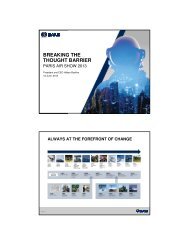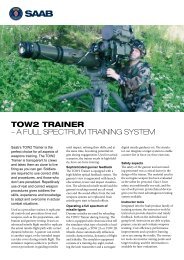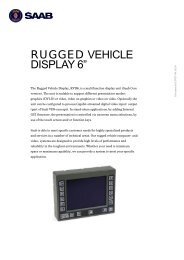financial information > notesStandardsImprovements to ifrs <strong>2009</strong>Will apply to financialyears beginning:Varies, earliest1 January <strong>2009</strong>Amendment to ifrs 1 First-time Adoption ofIFRS applies (Restructured version) on or after 1 July <strong>2009</strong>Amendment to ifrs 3 Business Combinations(Revised standard) on or after 1 July <strong>2009</strong>Amendment to ias 27 Consolidated and SeparateFinancial Statements (Revised standard) on or after 1 July <strong>2009</strong>Amendments to ias 39 Financial Instruments:Recognition and Measurement (Clarificationwhat can be considered hedged items) on or after 1 July <strong>2009</strong>Amendment to ifrs 1 First-time Adoption ofIFRS applies (Additional exemptions) on or after 1 January 2010Amendment to ifrs 2 Share-based Payment(Cash-settled share-based payment transactionsthat can be settled by other group companies) on or after 1 January 2010Amendment to ias 32 Financial Instruments:Presentation (Presentation of subscriptionrights)on or after 1 February2010Amendment to ias 24 Related Party Disclosures(Amended definition) on or after 1 January 2011ifrs 9 Financial Instruments on or after 1 January 2013ifric 17 Distributions of Non-cash Assets toOwners on or after 1 July <strong>2009</strong>ifric 19 Extinguishing Financial Liabilities withEquity Instruments on or after 1 July 2010Amendment to ifric 14 The Limit on a DefinedBenefit Asset, Minimum Funding Requirementsand their Interaction on or after 1 January 2011The above standards are not expected to have a material effect on the Group’sfinancial reports.Operating segmentsSegment information is presented based on management’s view, and operatingsegments are identified based on internal reporting to the company’schief operating decision maker. <strong>Saab</strong> has identified the Chief ExecutiveOfficer as its chief operating decision maker, while the internal reports usedby the ceo to oversee operations and make decisions on allocating resourcesserve as the basis of the information presented. The accounting principles forreportable segments conform to the principles applied by the Group as awhole.The Group had three reportable segments in <strong>2009</strong>:• Defence and Security Solutions• Systems and Products• AeronauticsSales of goods and services between segments are made on market terms.A detailed description of the segments, together with the factors used toidentify segments, can be found in note 4 and on pages 36-39As of 1 January 2010, <strong>Saab</strong>’s operations are divided into five business areas:Aeronautics, Dynamics, Electronic Defence Systems, Security and DefenceSolutions and Support and Services, which also will be reported as operatingsegments.Classification of assets and liabilitiesCurrent assets and current liabilities generally consist of amounts that can berecovered or paid within twelve months of the closing day. Other assets andliabilities are recognised as fixed assets or long-term liabilities.Consolidation principlesGroup companiesGroup companies are companies in which <strong>Saab</strong> AB has a decisive influencethrough a direct or indirect shareholding amounting to more than 50 percent. Unless, in exceptional circumstances, it can be clearly demonstratedthat such ownership does not constitute a decisive influence. Decisive influencealso exists when the parent owns half or less of the voting power of anentity but has a decisive influence over more than half the voting rights orpower to govern the financial and operating policies of the entity under astatute or an agreement. When determining whether a decisive influenceexists, potential voting shares that can be exercised or converted withoutdelay are taken into account.Subsidiaries and acquired operations (business combinations) are recognisedaccording to the purchase accounting method. This means that a businesscombination is treated as a transaction whereby the Group indirectlyacquires the business’s assets and takes over its liabilities and contingent liabilities.The Group’s cost is determined through an acquisition analysis withregard to the acquisition of operating entities. Cost is comprised of the sum ofthe fair value of what of is paid in cash, through the assumption of liabilities orshares issued as well as costs directly attributable to the acquisition. This analysisalso determines the fair value of acquired, identifiable assets and assumedliabilities and contingent liabilities. The difference between the cost of the subsidiary’sshares and the fair value of acquired assets, assumed liabilities andcontingent liabilities constitutes Group goodwill, which is recognised accordingto the section on intangible fixed assets. Acquisitions of minorities are recognisedaccording to the modified parent company model, which means thatassets and liabilities are not restated. The difference between cost and the carryingamount for the minority is recognised as additional goodwill.The financial reports of Group companies are included in the consolidatedaccounts from the point in time when a decisive influence arises(acquisition date) until this influence ceases.Associated companiesAssociated companies are companies over which the Group has a significant(but not decisive) influence over operating and financial controls, usuallythrough a shareholding of between 20 and 50 per cent of the votes. From thepoint in time when the significant influence arises, the shares in the associatedcompany are recognised according to the equity method in the consolidatedaccounts. The equity method is applied until the point in time when thesignificant influence ceases. The equity method means that the carryingamount of the shares in the associated company corresponds to the Group’sshare of the company’s equity based on an application of the Group’s accountingprinciples as well as Group goodwill and any remaining Group surplus ordeficit values. “Share in income of associated companies” in the income statementcomprises the Group’s share of the net income after tax and the minorityinterest in associated companies adjusted for any depreciation, impairmentloss or dissolution of acquired surplus and deficit values determined inthe same way as for operating acquisitions. Dividends received from the associatedcompany reduce the carrying amount of the investment.If the Group’s share of the accumulated deficit in an associated companyexceeds the carrying amount of the shares in the Group, the value of the sharesis reduced to nil. Losses are also offset against long-term uncollateralised financialbalances that in their economic significance represent part of the ownercompany’snet investment in the associated company. Subsequent losses are notrecognised as a liability in the consolidated accounts as long as the Group hasnot issued any guarantees to cover losses arising in the associated company.Joint venturesCompanies in which the Group, through a cooperative agreement with oneof more parties, shares a decisive influence over operating and financial controlsare recognised in the consolidated accounts according to the proportionalmethod. For joint ventures, this means that the Group’s share of the72 saab annual report <strong>2009</strong>
financial information > notescompanies’ revenue and expenses and their assets and liabilities is recognisedin the consolidated income statement and balance sheet, respectively, basedon application of the Group’s accounting principles. This is done by combining<strong>Saab</strong>’s share of revenue and expenses and assets and liabilities in the jointventure with the corresponding items in the consolidated accounts.Eliminated transactionsIntra-Group receivables and liabilities, revenue or expenses, and gains orlosses that arise from transactions between Group companies are eliminatedin their entirety in the preparation of the consolidated accounts.Gains that arise from transactions with associated companies and jointventures are eliminated to an extent corresponding to the Group’s ownershipinterest in the company. Losses are eliminated in the same way as gains, butonly to the extent there that is no impairment loss.Foreign currencyFunctional currencies are the currencies in each primary economic environmentwhere units of the Group conduct their operations.Transactions and assets and liabilities in foreign currencyTransactions in foreign currency are recognised in the functional currency atthe exchange rate on the transaction day. Monetary assets and liabilities aretranslated to the functional currency on the closing day at the exchange ratethen in effect. Exchange rate differences that arise through these translationsare recognised in profit and loss. Non-monetary assets and liabilities recognisedat fair value are translated to the functional currency at the rate in effectat the time of valuation at fair value. Changes in exchange rates are then recognisedin the same way as other changes in value of the asset or liability.Translation of financial reports of foreign operations to sekAssets and liabilities in operations with a functional currency other than sekare translated to sek at the closing day exchange rate. Revenue and expensesin foreign operations are translated to sek at the average rate. Translation differencesthat arise through currency translations are recognised directly inthe comprehensive income. The amount is recognised separately as a translationreserve in equity.RevenueSales of goodsRevenue from the sale of goods is recognised in profit or loss when the significantrisks and benefits associated with ownership have transferred to the buyer.Service assignmentsRevenue from service assignments is recognised when the services are rendered.Revenue from services rendered as part of fixed-price contracts is recognisedin accordance with the principles that apply to long-term customeragreements; see below. Revenue is recognised only if it is likely that the economicbenefits will accrue to the Group. If it is unlikely that payment will bereceived, there is uncertainty with regard to the level of related expenses orthere is a risk of returns, no revenue is recognised.Long-term customer agreementsA large part of the Group’s operations comprises long-term customer agreements.When such agreements concern development and hardware that canbe reliably calculated, revenue and expenditures attributable to the assignmentare recognised in the consolidated income statement in relation to theassignment’s stage of completion, i.e., according to the percentage of completionmethod.The stage of completion is based on a determination of the relationshipbetween expenditures incurred for services rendered as of the closing dayand estimated total expenditures. Of the estimated total revenue for anassignment, including interest on advance payments, the portion correspondingto the stage of completion is recognised in each period. The stage ofcompletion can also be determined in certain cases based on milestones ordeliveries. With regard to orders whose manufacturing cost is financed to asignificant extent with advance payment from customers, the effect on interestof advance financing is recognised in gross income. The interest amountthat affected gross income is indicated in Note 13.An anticipated loss is recognised in profit or loss as soon as it is identified.Recognised subcontracting revenue for which the customer has not yetbeen invoiced is recognised as a receivable from that customer.Operating expensesThe income statement is classified according to function as follows:• Cost of goods sold comprises costs for material handling and manufacturingcosts, including salary and material costs, purchased services,premises, and the depreciation/amortisation and impairment of intangibleand tangible fixed assets.• Administrative expenses relate to expenses for the Board of Directors,Group Management and staff functions.• Marketing expenses comprise expenses for the in-house sales organisation,including sales companies, advertising and exhibits.• Research and development costs are recognised separately and comprisethe cost of new and continued product development as well ascapitalised development costs; see below.• Other operating revenue and expenses relate to secondary activities, exchangerate differences on items of an operating nature, changes in thevalue of derivatives of an operating nature and capital gains/losses onthe sale of tangible fixed assets. Also included at the Group level are capitalgains/losses on the sale of subsidiaries and associated companies.Government grantsGovernment grants are recognised in the balance sheet as prepaid incomewhen there is reasonable certainty that the grant will be received and that theGroup will meet the conditions associated with the grant. Grants are systematicallyrecognised in the income statement in the same way and over thesame periods as the expenses for which the grants are intended to compensate.Government grants related to assets are recognised in the balance sheetas a reduction in the asset’s carrying amount.Financial revenue and expensesFinancial revenue and expenses consist of interest income on bank balances,receivables and marketable securities, interest expenses on loans, dividends,exchange rate differences, unrealised and realised gains on financial investmentsand derivatives used in financial operations.Intangible fixed assetsGoodwillGoodwill is distributed among cash-generating units and tested annually forimpairment. Goodwill arising through the acquisition of associated companiesis included in the carrying amount of the shares in the associated company.In acquisitions where the cost is less than the net of the fair value ofacquired assets, assumed liabilities and contingent liabilities, the difference isrecognised directly through profit or loss.Research and developmentExpenditures for research undertaken in an effort to gain new scientific ortechnological knowledge are expensed when incurred.Expenditures for development, where the research results or other knowledgeis applied to new or improved products or processes, are recognised asan asset in the balance sheet from the time when the product or process in thefuture is expected to be technically and commercially usable, the companyhas sufficient resources to complete development and subsequently use or sellthe intangible asset, and the product or process is likely to generate futureeconomic benefits. The carrying amount includes expenditures for material,direct expenditures for salaries and, if applicable, other expenditures that areconsidered directly attributable to the asset. Other expenditures for developmentare recognised in profit for loss as an expense when they arise. Expendituresrecognised in the balance sheet are carried at cost less accumulatedamortisation and impairment loss.Other intangible fixed assetsOther acquired intangible fixed assets are recognised at cost less accumulatedamortisation and impairment losses.saab annual report <strong>2009</strong> 73




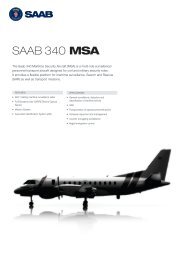
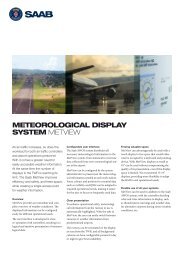
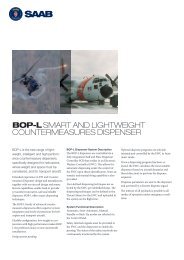

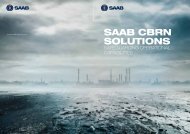
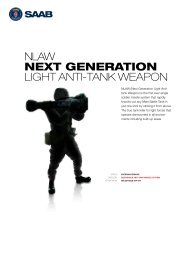
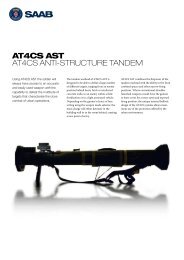

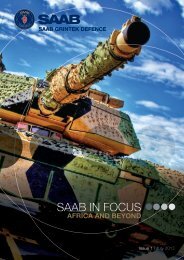
![Proposal long-term incentive programs [pdf] - Saab](https://img.yumpu.com/50411723/1/190x245/proposal-long-term-incentive-programs-pdf-saab.jpg?quality=85)
